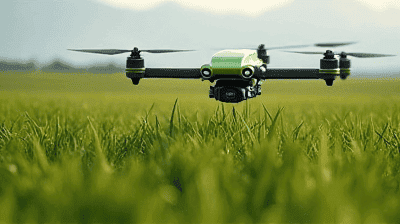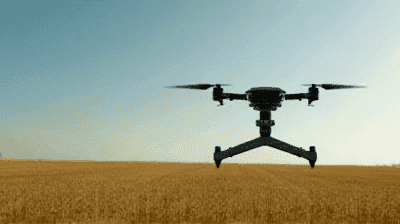
The agriculture industry is experiencing a transformative revolution fueled by advancements in technology. As the global population continues to grow, the demand for sustainable food production intensifies. Traditional farming practices are being enhanced and optimized through the integration of artificial intelligence (AI) and drones, leading to the emergence of smart farming.
The Evolution of Farming: From Manual Labor to Automation
The Historical Context
Farming has come a long way since the days of manual labor and simple tools. Over centuries, innovations such as plowing, irrigation, and selective breeding laid the groundwork for agricultural development. The Industrial Revolution marked a significant turning point, introducing mechanization that revolutionized farming by improving efficiency and productivity.
The Rise of Precision Agriculture
In recent decades, the term "precision agriculture" has gained traction as farmers seek to optimize crop production through data-driven decision-making. Precision agriculture relies on technologies that allow farmers to monitor and manage variables affecting crop yields, such as soil moisture, nutrient levels, and pest presence. This approach lays the foundation for the integration of AI and drones, which are taking precision farming to new heights.
The Role of AI in Modern Agriculture

Understanding AI in Agriculture
Artificial intelligence refers to the simulation of human intelligence in machines designed to think and learn. In agriculture, AI systems analyze vast amounts of data to provide actionable insights that help farmers make informed decisions.
Data Collection and Analysis: AI systems leverage data from various sources, including satellite imagery, soil sensors, and weather forecasts, to assess crop health and predict yields. This data-driven approach enables farmers to respond proactively to changing conditions.
Machine Learning Algorithms: AI utilizes machine learning algorithms to improve predictions and recommendations over time. As more data is collected, the algorithms become more sophisticated, refining their insights and enhancing decision-making capabilities.
Applications of AI in Agriculture
AI is transforming multiple aspects of farming. Some key applications include:
Crop Monitoring: AI-driven systems can analyze images captured by drones and satellites to monitor crop health, identify nutrient deficiencies, and detect diseases early. This proactive approach allows farmers to address issues before they escalate.
Yield Prediction: Machine learning models can predict crop yields based on historical data and environmental conditions, helping farmers make better planning and resource allocation decisions.
Pest and Disease Management: AI algorithms can analyze data from various sources to identify potential pest threats and diseases. By providing timely alerts, farmers can implement targeted interventions, reducing reliance on pesticides.
Automated Irrigation Systems: Smart irrigation systems use AI to optimize water usage based on real-time data from soil moisture sensors and weather forecasts. This ensures crops receive the right amount of water while minimizing waste.
Drones: The Eyes in the Sky
The Functionality of Agricultural Drones
Drones, also known as unmanned aerial vehicles (UAVs), have become invaluable tools in modern agriculture. Equipped with high-resolution cameras and sensors, drones can capture detailed images and data that provide insights into crop health and field conditions.
Multispectral Imaging: Drones equipped with multispectral cameras can capture images in different wavelengths, allowing farmers to assess crop health, monitor plant growth, and identify areas requiring attention.
Geospatial Mapping: Drones enable the creation of detailed maps of fields, providing information on soil types, topography, and moisture levels. This geospatial data enhances land management and planning.
Applications of Drones in Agriculture
Drones are revolutionizing several agricultural practices through their versatile applications:
Crop Inspections: Farmers can use drones to conduct routine inspections of their fields. Drones enable rapid and thorough evaluations of crop health, which can be more efficient than traditional ground-based assessments.
Precision Spraying: Drones can be programmed to spray fertilizers and pesticides precisely where needed, minimizing chemical waste and enhancing effectiveness.
Planting: Some innovative agricultural companies are developing drones designed for seed planting. These drones can plant seeds in hard-to-reach areas, increasing efficiency and reducing labor costs.
Livestock Monitoring: Drones can also be used to monitor livestock, providing farmers with a bird's eye view of their herding conditions and well-being.
Creating Intelligent Farming Ecosystems

Integration of AI and Drones
The true potential of technology in agriculture lies in the integration of AI and drones. Combining real-time data from drones with AI analytics creates a comprehensive farming ecosystem capable of making data-driven decisions.
Holistic Approach: By using drones to gather data on soil health, crop conditions, and weather patterns, AI algorithms can process this information to provide tailored recommendations for each farm's unique conditions.
Improved Resource Management: The synergy between AI and drones allows farmers to optimize resource use. For example, AI can analyze drone-collected data to determine the optimal amount of water or fertilizer needed for specific areas of a field.
Case Studies in Intelligent Farming
Precision Planting in the United States: Farmers in the Midwest have implemented drone technology to assess soil conditions before planting. AI algorithms analyze the data collected by drones, allowing farmers to select planting strategies that maximize yields.
Pest Management in Brazil: In Brazil, farmers employ drones to gather data on pest infestations. AI-driven analytics identify the most effective treatment options, reducing pesticide use while maintaining productivity.
The Benefits of Robotics in Agriculture
Enhanced Productivity and Efficiency
The integration of AI and drones in farming leads to significant productivity gains. By automating repetitive tasks and streamlining operations, farmers can focus on strategic decision-making rather than manual labor.
Labor Shortages: The agriculture sector is facing a growing labor shortage. Robotics can compensate for the lack of available workers by performing tasks such as planting, harvesting, and monitoring, mitigating the impact of labor challenges.
Reduced Operational Costs: Automated systems reduce operational costs by optimizing resource use, lowering input costs, and minimizing waste. This enhances the profitability of farming operations.
Environmental Sustainability
The adoption of technology in agriculture also has significant implications for environmental sustainability.
Reduced Chemical Use: Precision application of fertilizers and pesticides, enabled by drones and AI analytics, leads to reduced chemical runoff and lower environmental impacts compared to traditional broad-spectrum applications.
Water Conservation: Smart irrigation systems driven by AI can optimize water usage, ensuring that crops receive the right amount of water without waste. This helps preserve vital water resources in agricultural regions facing water scarcity.
Carbon Footprint Reduction: Improving farming efficiency through technology can contribute to a reduction in the carbon footprint of agriculture. Implementing sustainable practices, such as reduced chemical inputs and efficient resource management, supports environmental health.
Challenges and Considerations

Technological Barriers
While the potential benefits of using AI and drones in agriculture are substantial, several barriers to adoption remain:
High Initial Costs: Investing in drones and AI systems can be prohibitively expensive for small and medium-sized farms. While costs are gradually coming down, many farmers may still require support to integrate these technologies effectively.
Technical Expertise: Farmers may lack the technical skills necessary to operate advanced technologies. Training and support programs are essential for empowering farmers to utilize these tools successfully.
Data Privacy and Security: Increased reliance on data collection raises concerns about privacy and security. Farmers must ensure that their data is protected and that they have control over how it is used.
Ethical and Social Implications
Job Displacement: Increased automation in agriculture may lead to job displacement, particularly for labor-intensive positions. Policies should be established to assist workers transitioning to new roles and ensure social equity.
Consolidation of Power: The agricultural sector's reliance on technology created by a small number of large companies raises concerns about market consolidation and the potential for monopolistic practices. Supporting fair competition and innovation is vital for overall industry health.
The Future of Agriculture: Robotics and AI
Emerging Trends
The future of agriculture is poised to be shaped by continued advancements in robotics, AI, and drone technology. Some emerging trends include:
Advanced Robotics: Developments in robotics will continue to evolve, leading to machines capable of performing increasingly sophisticated tasks, including selective harvesting and automated weeding.
Autonomous Vehicles: Self-driving tractors and autonomous field vehicles will be part of the agricultural landscape, optimizing field operations and reducing the need for human intervention.
Blockchain Technology: Blockchain can enhance traceability in agriculture, providing transparency in food supply chains. Implementing AI algorithms to analyze blockchain data can improve decision-making and accountability.
Embracing Sustainable Practices
The integration of AI and drone technology can drive sustainable practices in agriculture. By minimizing chemical use, optimizing resource management, and facilitating efficient land use, technology can support a more sustainable agricultural framework.
Regenerative Agriculture: Adopting regenerative practices, which focus on restoring soil health and enhancing biodiversity, can be facilitated through technology. AI-driven data analyses can provide recommendations on crop rotations and soil management.
Urban and Vertical Farming: As urbanization continues to expand, technology will play a crucial role in the future of food production in cities. Drones and AI can support vertical farming initiatives, optimizing growing conditions and energy use in urban environments.
Conclusion
The integration of AI and drones in agriculture marks a turning point in how we produce food and manage resources. By harnessing technology, farmers can enhance productivity, improve sustainability, and address the challenges posed by an ever-growing global population. While barriers to adoption remain, the potential benefits are undeniable.
As we look towards the future of farming, embracing innovation and supporting equitable access to technology will be critical. The evolution of agriculture is not just about machines and data; it is about ensuring food security, promoting environmental sustainability, and enhancing the livelihoods of farmers worldwide. With robots in the fields, we are on the cusp of a new agricultural era where technology and nature work hand in hand to create a better future for all.








